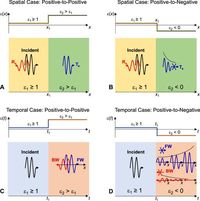A novel mechanism for controlling and amplifying electromagnetic waves has been introduced, potentially revolutionizing the way these waves interact with materials. By rapidly changing the permittivity of the medium in which the waves propagate, researchers have demonstrated the ability to effectively freeze the waves in time, allowing their amplitudes to grow exponentially before releasing them to resume their original frequency.
The study, led by V. Pacheco-Peña and colleagues, explores the underlying physics through the propagation of plane waves and Gaussian pulses within an unbounded medium. This innovative approach utilizes a rapid switch of the permittivity from a positive value to a non-Foster negative value, effectively creating a medium that can hold the wave in a frozen state while its amplitude intensifies.
At a critical time, when the medium's permittivity is returned to a positive value, the wave is allowed to thaw and continue propagating with either its original or a new frequency. Such a process opens up new avenues for controlling wave-matter interactions, which could have broad implications across various scientific fields.
The experimental framework proposed includes a two-dimensional parallel plate waveguide, designed to house these time-dependent media that emulate parallel lumped non-Foster negative capacitors. This configuration allows for a smooth transition of the permittivity over time, showcasing the remarkable control over wave behavior.
In their findings, the researchers illustrate that when the permittivity is switched from a positive value of 1 to a negative value of -20 at a designated time (t1 = 37.1 T), the electromagnetic wave is effectively frozen for a period, with its amplitude exceptionally increasing. This control can be extended, as seen in another configuration where the permittivity changes from a negative value of -15 to a positive value of 10, still allowing for amplitude growth during the frozen state.
The waveguide utilized in this study spans 6λ1 in length and showcases 75 non-Foster negative capacitors placed strategically to facilitate the rapid change in permittivity needed for the desired effects. Previously established models of wave slowing and spatial trapping offered a foundation that made this recent innovation possible.
Moreover, the potential applications of this technology extend far beyond academic interest. The ability to freely control wave thresholds and behaviors hints at breakthroughs in creating coherent light sources as well as enhancing telecommunication signals. As electromagnetic waves can be slowed, stopped, or amplified, the possibilities latent within this research could redefine signal processing.
This work is not merely theoretical; it has been numerically evaluated using simulations and laboratory setups that closely mirror the proposed scenarios, providing a robust understanding of how these mechanisms may function in practice. The results suggest an exciting frontier in optics and electromagnetism, with future research dedicated to refining these systems for practical applications.
As scientists continue to explore the nuances of temporal metamaterials and non-Foster structures, the implications of this mechanism for amplifying and holding electromagnetic waves could herald a new way of approaching wave applications—one that embodies precision and control in manipulating light.
In conclusion, the mechanisms discussed herein illustrate how temporal terrapins of wave management hold promise, inviting future investigations. As this field of research grows, the development of new technologies to harness these capabilities may soon empower diverse applications, ranging from advanced imaging systems to enhanced materials for industry.

